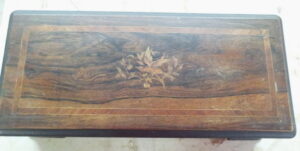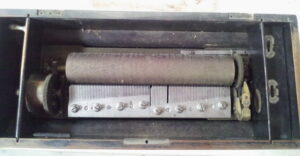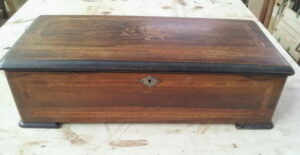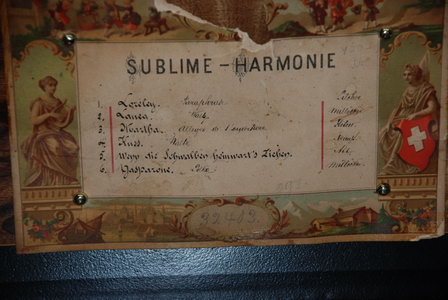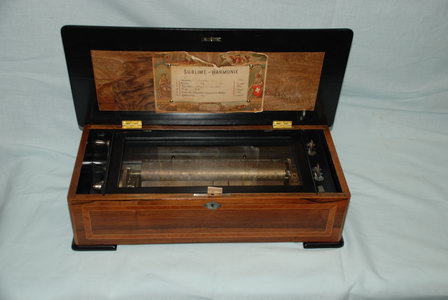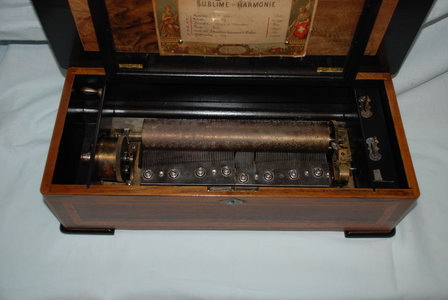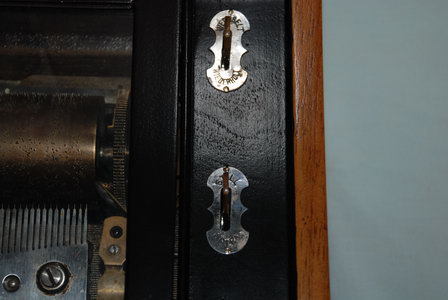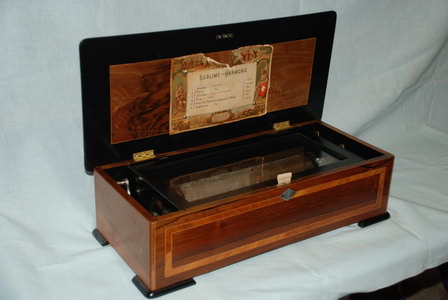Our last project for 2011 may have been one of the most interesting for me. Late in the year we were approached by our new client Pat to restore a family heirloom music box. He really wanted it completed before Christmas since it was a gift. The story was compelling so we agreed to have it complete in time to be presented at Christmas.
I may have the story slightly out of sequence, but this is how I understand it. The music box has been in his family for several generations. We were not able to determine the exact age as there are no manufacturing marks anywhere. After several generations, the music box was in Pat’s mothers possession. She decided to give it to Pat. After being told he was receiving it, he came to us for the restoration. He restored it for his mother as a Christmas gift, and in turn, she is giving it to Pat.
Once I saw the piece, I was hooked. Music boxes are something of a fascination to me. The mechanism of a good music box is truly a mechanical marvel. I couldn’t wait to start taking it apart and restoring it. These photos show what it looked like upon arrival.
When it came to us one of Pat’s requests was for us to make it play. It appeared that it had been wound to tightly and was stuck. The problem turned out to be twofold. The first problem was the dirt. Years and years of dust had been attracted to the moving parts and the lubricant used on them. After a careful cleaning of the mechanism and frame, it worked perfectly. The second problem was the start lever. The visible lever actually moves another lever on the mechanism itself. The end had broken off and the two didn’t meet. A new piece was fabricated so that is functions correctly now.
When we disassembled it I was drawn to the labels on the two levers. Each lever has two positions with an indication of the function. You can see in the photo that the rear lever is marked “Wechselt” and “Wiederholt”. The front lever is marked “Still” and “Spiel”. Curiosity got the best of me and I went to Google for a translation. The front lever was sort of obvious – “Still” translated to “Quiet” and “Spiel” translated to “Play”. The rear lever proved more interesting, I found that “Wechselt” translates to “alternates” and “Wiederholt” translates to “Repeats”. Discovering this created another mystery – alternates or repeats what?
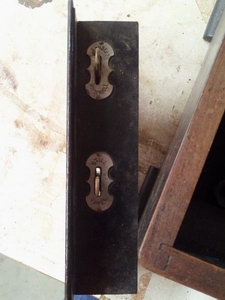 Inside the lid was a handwritten label with song titles that was a big clue to that mystery.
Inside the lid was a handwritten label with song titles that was a big clue to that mystery.
After everything was cleaned and reassembled we were able to find the answer. The cylinder has barbs for six songs. What was really fascinating to me is how it plays all six songs. The music box starts to play when you move the lever from Still to Spiel. As the cylinder rotates, the barbs pluck the end of the teeth on the combs. If you move it back to Still, the cylinder will turn one revolution, playing one song, and stop. If you leave the lever in the Spiel position, it will continue to rotate. With the rear lever in the Wiederholt position, it will repeat the same song. With the lever in the Wechselt position, it will alternate songs with each revolution of the cylinder.
After learning the meaning of the labels, I wanted to know how one cylinder could play six songs. As I watched the cylinder revolve, I could see that moving the rear lever moved a pin into, or out of, the path of a gear on the end of the cylinder. In simple terms, here’s what happens. With the lever in the Wechselt, or alternates, position a pin is put in the path of the gear on the cylinder. When the cylinder revolves and this gear touches the pin, the gear rotates 1/6th of a revolution causing the entire cylinder to move slightly to the side. After six revolutions, the cylinder returns to the first position.
I may have bored you to death with that explanation, but it was fascinating for me to watch. I can only imagine the mind of the maker while designing that mechanism.
The box itself is a beautiful rosewood veneer with the interior finished in black. We removed the old finish and years of dirt. Once that was complete, we discovered that the interior of the lid was veneered in a lovely crotch veneer with an inlaid stringing border. There were some repairs needed including reattaching the feet, gluing the interior dividers, replacing the glass, and some minor work on the veneer.
We decided to leave the crotch veneer and stringing visible on the interior. The remaining interior surfaces (and the feet) were finished in a black lacquer. The entire box received several coats of clear lacquer which really made the rosewood figure pop. Here it is, ready to make music for many generations to come.
Thanks for reading, check back soon – 2012 has some interesting projects scheduled.

